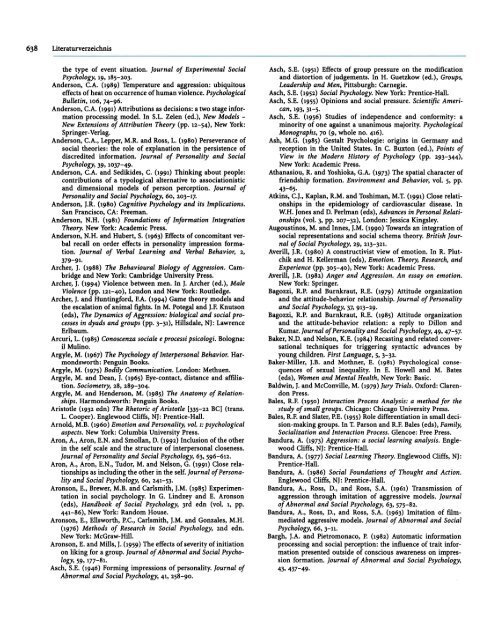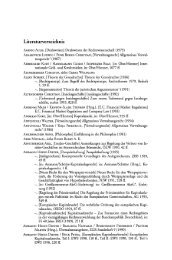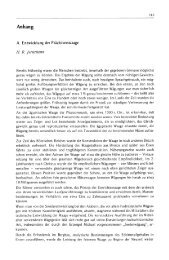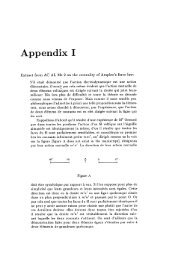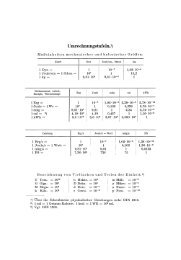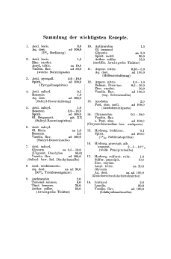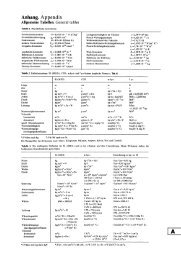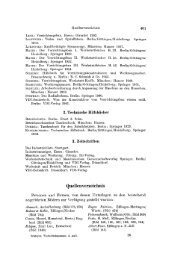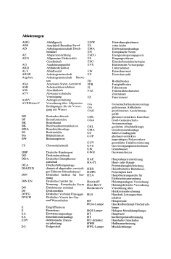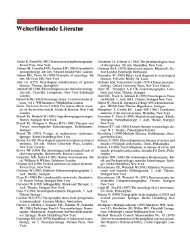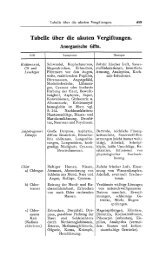Glossar - Springer
Glossar - Springer
Glossar - Springer
Create successful ePaper yourself
Turn your PDF publications into a flip-book with our unique Google optimized e-Paper software.
638 Literaturverzeichnisthe type of event situation. Journal of Experimental SocialPsychology, 19, 185-203.Anderson, C.A. (1989) Temperature and aggression: ubiquitouseffects of heat on occurrence of human violence. PsychologicalBulletin, 106, 74-96.Anderson, C.A. (1991) Attributions as dedsions: a two stage informationprocessing model. In S.L. Zelen (ed.), New Models -New Extensions of Attribution Theory (pp. 12-54), New York:<strong>Springer</strong>-Verlag.Anderson, C.A., Lepper, M.R. and Ross, L. (1980) Perseverance ofsodal theories: the role of explanation in the persistence ofdiscredited information. Journal of Personality and SocialPsychology, 39, 1037-49.Anderson, C.A. and Sedikides, C. (1991) Thinking about people:contributions of a typological alternative to assodationisticand dimensional models of person perception. Journal ofPersonality and Social Psychology, 60, 203-17.Anderson, J.R. (1980) Cognitive Psychology and its Implications.San Frandsco, CA: Freeman.Anderson, N.H. (1981) Foundations of Information IntegrationTheory. New York: Academic Press.Anderson, N.H. and Hubert, S. (1963) Effects of concomitant verbalrecall on order effects in personality impression formation.Journal of Verbal Learning and Verbal Behavior, 2,379-91.Archer, J. (1988) The Behavioural Biology of Aggression. Cambridgeand New York: Cambridge University Press.Archer, J. (1994) Violence between men. In J. Archer (ed.), MaleViolence (pp. 121-40), London and New York: Routledge.Archer, J. and Huntingford, F.A. (1994) Game theory models andthe escalation of animal fights. In M. Potegal and J.F. Knutson(eds), The Dynamics of Aggression: biological and social processesin dyads and groups (pp. 3-31), Hillsdale, NJ: LawrenceErlbaum.Arcuri, L. (1985) Conoscenza sociale e processi psicologi. Bologna:il Mulino.Argyle, M. (1967) The Psychology of Interpersonal Behavior. Harmondsworth:Penguin Books.Argyle, M. (1975) Bodily Communication. London: Methuen.Argyle, M. and Dean, J. (1965) Eye-contact, distance and affiliation.Sociometry, 28, 289-304.Argyle, M. and Henderson, M. (1985) The Anatomy of Relationships.Harmondsworth: Penguin Books.Aristotle (1932 edn) The Rhetoric of Aristotle [335-22 Be] (trans.L. Cooper). Englewood Cliffs, NJ: Prentice-Hall.Arnold, M.B. (1960) Emotion and Personality, vol. 1: psychologicalaspects. New York: Columbia University Press.Aron, A., Aron, E.N. and Smollan, D. (1992) Inclusion of the otherin the self scale and the structure of interpersonal closeness.Journal of Personality and Social Psychology, 63, 596-612.Aron, A., Aron, E.N., Tudor, M. and Nelson, G. (1991) Close relationshipsas including the other in the self. Journal of Personalityand Sodal Psychology, 60, 241-53.Aronson, E., Brewer, M.B. and Carlsmith, J.M. (1985) Experimentationin sodal psychology. In G. Lindzey and E. Aronson(eds), Handbook of Social Psychology, 3rd edn (vol. 1, pp.441-86), New York: Random House.Aronson, E., Ellsworth, P.C., Carlsmith, J.M. and Gonzales, M.H.(1976) Methods of Research in Social Psychology, 2nd edn.New York: McGraw-Hill.Aronson, E. and Mills, J. (1959) The effects of severity of initiationon liking for a group. Journal of Abnormal and Social Psychology,59, 177-81.Asch, S.E. (1946) Forming impressions of personality. Journal ofAbnormal and Sodal Psychology, 41, 258-90.Asch, S.E. (1951) Effects of group pressure on the modificationand distortion of judgements. In H. Guetzkow (ed.), Groups,Leadership and Men, Pittsburgh: Carnegie.Asch, S.E. (1952) Social Psychology. New York: Prentice-Hall.Asch, S.E. (1955) Opinions and sodal pressure. Scientific American,193, 31-5.Asch, S.E. (1956) Studies of independence and conformity: aminority of one against a unanimous majority. PsychologicalMonographs, 70 (9, whole no. 416).Ash, M.G. (1985) Gestalt Psychologie: origins in Germany andreception in the United States. In C. Buxton (ed.), Points ofView in the Modern History of Psychology (pp. 293-344),New York: Academic Press.Athanasiou, R. and Yoshioka, G.A. (1973) The spatial character offriendship formation. Environment and Behavior, vol. 5, pp.43-65.Atkins, C.J., Kaplan, R.M. and Toshiman, M.T. (1991) Close relationshipsin the epidemiology of cardiovascular disease. InW.H. Jones and D. Perlman (eds), Advances in Personal Relationships(vol. 3, pp. 207-32), London: Jessica Kingsley.Augoustinos, M. and Innes, J.M. (1990) Towards an integration ofsodal representations and sodal schema theory. British Journalof Social Psychology, 29, 213-321.Averill, J.R. (1980) A constructivist view of emotion. In R. Plutchikand H. Kellerman (eds), Emotion. Theory, Research, andExperience (pp. 305-40), New York: Academic Press.Averill, J.R. (1982) Anger and Aggression. An essay on emotion.New York: <strong>Springer</strong>.Bagozzi, R.P. and Burnkraut, R.E. (1979) Attitude organizationand the attitude-behavior relationship. Journal of Personalityand Sodal Psychology, 37, 913-29.Bagozzi, R.P. and Burnkraut, R.E. (1985) Attitude organizationand the attitude-behavior relation: a reply to Dillon andKumar. Journal ofPersonality and Sodal Psychology, 49, 47-57.Baker, N.D. and Nelson, K.E. (1984) Recasting and related conversationaltechniques for triggering syntactic advances byyoung children. First Language, 5, 3-32.Baker-Miller, J.B. and Mothner, E. (1981) Psychological consequencesof sexual inequality. In E. Howell and M. Bates(eds), Women and Mental Health, New York: Basic.Baldwin, J. and McConville, M. (1979) Jury Trials. Oxford: ClarendonPress.Bales, R.F. (1950) Interaction Process Analysis: a method for thestudy of sm all groups. Chicago: Chicago University Press.Bales, R.F. and Slater, P.E. (1955) Role differentiation in small dedsion-makinggroups. In T. Parson and R.F. Bales (eds), Family,Socialization and Interaction Process. Glencoe: Free Press.Bandura, A. (1973) Aggression: a sodal learning analysis. EnglewoodCliffs, NJ: Prentice-Hall.Bandura, A. (1977) Sodal Learning Theory. Englewood Cliffs, NJ:Prentice-Hall.Bandura, A. (1986) Sodal Foundations of Thought and Action.Englewood Cliffs, NJ: Prentice-Hall.Bandura, A., Ross, D., and Ross, S.A. (1961) Transmission ofaggression through imitation of aggressive models. Journalof Abnormal and Sodal Psychology, 63, 575-82.Bandura, A., Ross, D., and Ross, S.A. (1963) Imitation of filmmediatedaggressive models. Journal of Abnormal and SodalPsychology, 66, 3-11.Bargh, J.A. and Pietromonaco, P. (1982) Automatic informationprocessing and sodal perception: the influence of trait informationpresented outside of consdous awareness on impressionformation. Journal of Abnormal and Sodal Psychology,43,437-49·


